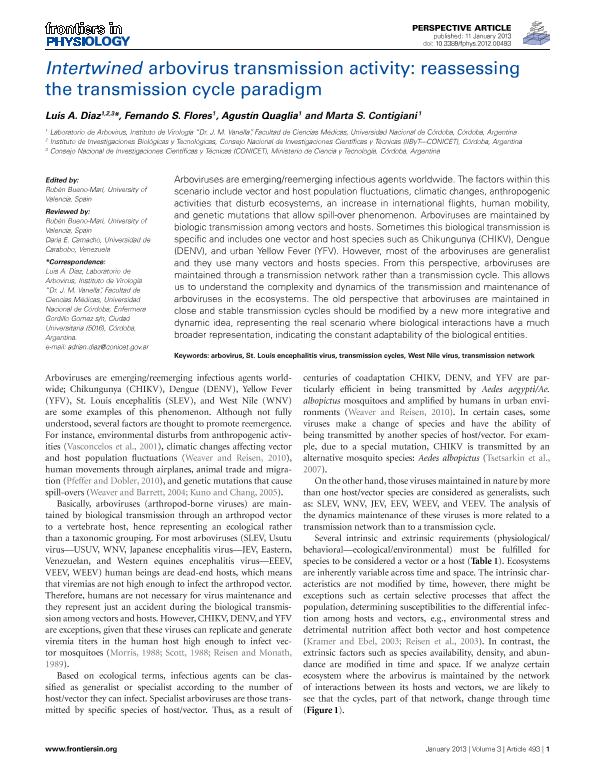Artículo
Intertwined arbovirus transmission activity: reassessing the transmission cycle paradigm
Diaz, Luis Adrian ; Flores, Fernando Sebastián
; Flores, Fernando Sebastián ; Quaglia, Agustín Ignacio Eugenio
; Quaglia, Agustín Ignacio Eugenio ; Contigiani de Minio, Marta Silvia
; Contigiani de Minio, Marta Silvia
 ; Flores, Fernando Sebastián
; Flores, Fernando Sebastián ; Quaglia, Agustín Ignacio Eugenio
; Quaglia, Agustín Ignacio Eugenio ; Contigiani de Minio, Marta Silvia
; Contigiani de Minio, Marta Silvia
Fecha de publicación:
2013
Editorial:
Frontiers Media SA
Revista:
Frontiers in Phisiology
e-ISSN:
1664-042X
Idioma:
Inglés
Tipo de recurso:
Artículo publicado
Clasificación temática:
Resumen
Arboviruses are emerging/reemerging infectious agents worldwide. The factors within this scenario include vector and host population fluctuations, climatic changes, anthropogenic activities that disturb ecosystems, an increase in international flights, human mobility, and genetic mutations that allow spill-over phenomenon. Arboviruses are maintained by biologic transmission among vectors and hosts. Sometimes this biological transmission is specific and includes one vector and host species such as Chikungunya (CHIKV), Dengue (DENV), and urban Yellow Fever (YFV). However, most of the arboviruses are generalist and they use many vectors and hosts species. From this perspective, arboviruses are maintained through a transmission network rather than a transmission cycle. This allows us to understand the complexity and dynamics of the transmission and maintenance of arboviruses in the ecosystems. The old perspective that arboviruses are maintained in close and stable transmission cycles should be modified by a new more integrative and dynamic idea, representing the real scenario where biological interactions have a much broader representation, indicating the constant adaptability of the biological entities.
Archivos asociados
Licencia
Identificadores
Colecciones
Articulos(CCT - CORDOBA)
Articulos de CTRO.CIENTIFICO TECNOL.CONICET - CORDOBA
Articulos de CTRO.CIENTIFICO TECNOL.CONICET - CORDOBA
Articulos(IIBYT)
Articulos de INSTITUTO DE INVESTIGACIONES BIOLOGICAS Y TECNOLOGICAS
Articulos de INSTITUTO DE INVESTIGACIONES BIOLOGICAS Y TECNOLOGICAS
Citación
Diaz, Luis Adrian; Flores, Fernando Sebastián; Quaglia, Agustín Ignacio Eugenio; Contigiani de Minio, Marta Silvia; Intertwined arbovirus transmission activity: reassessing the transmission cycle paradigm; Frontiers Media SA; Frontiers in Phisiology; 3; 493; 2013; 1-7
Compartir
Altmétricas



